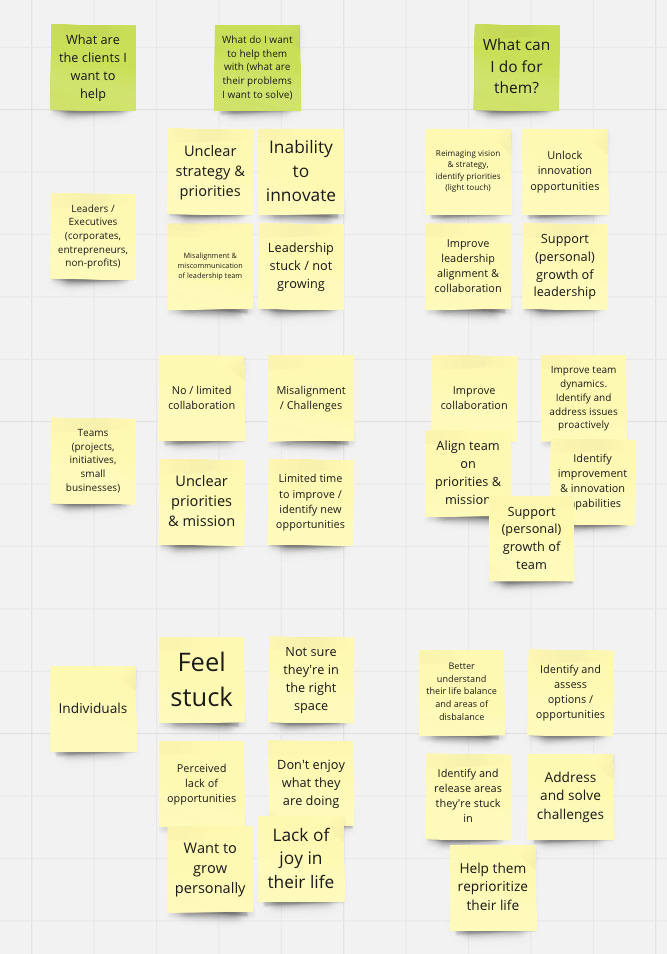Beyond the Self: Your Next Phase
Focus on Impact Rather Than Intent to Move Into Your Next Phase
Finding yourself at a point where you are unsure of where to go next professionally can be draining. To move forward, we sometimes need to take a step back and make space for a new perspective.
One exercise that can help unlock your potential is to shift the focus away from you and instead direct it towards the impact you can make on others and the world.
It can help to change your perspective away from “what do I want” and towards “how can I be of service?” Sometimes, that's enough to release a block and make the energy flow again.
The exercise is quite simple.
First, choose who you want to work with.
You could say, "I want to work with founders," or "I want to work with leadership teams," or you can work with families. Or start-ups in the sustainability space. Or immigrants. Or plumbers. Or actors. Or your community. Or your industry.
While it helps to be as specific as possible, you can certainly have 2-3 different types of “prospective clients”.
For example, when I first went through this exercise, I had three categories. The first one was leaders and executives, which could be from corporations, entrepreneurs, or nonprofits. These are people who lead initiatives and are driven, proactive, and want to make a change. The second group was teams, such as project teams, initiatives, or even small businesses with three or four team members. This was interesting for me because I've worked a lot with teams in my corporate times, particularly in the space of innovation. The third category was individuals, without focusing on specific types of individuals (this one was a bit broad, in hindsight).
The second step is to understand their challenges and real problems.
Now, take on the perspective of these potential clients that you have selected and brainstorm their challenges. Forget yourself for now, and try to understand what they are battling with.
For example, in my case, leaders and executives often have to deal with uncertainty, unclear strategies and priorities. They also often struggle to balance work and life, feeling overwhelmed or lacking joy in their life. Or, they may no longer enjoy their work and feel stuck. Common challenges for teams include limited collaboration, unclear priorities and strategy, and misaligned interests.
By identifying these challenges for each client group, you can determine how best to assist them. If you’re not quite sure, it can be quite an inspiring exercise to call up some people in that category from your network, and just ask “so - what’s going on, what are you battling with these days?”, and you may be surprised.
The third step is to get clear on how you can help.
How can you help these groups address their problems with your knowledge, expertise, and experience? For example, you could help leaders and executives clarify their priorities and develop a strategy. In cases of misaligned teams, you could help them address challenges, improve collaboration, and align their strategies. For individuals feeling stuck, you could help them gain new perspectives and move forward.
By completing this process, you'll gain valuable insights about your strengths and the value you can provide to various groups. It is also an overview of possible clients you may want to work with, the challenges they are facing, and some ideas on how you could help them. This is your Value Proposition!
The final, crucial step → find your energy
The next crucial step is to identify where your energy goes and what activities you are most passionate about. Review your notes, and circle the areas that you feel most drawn towards. This is also an opportunity to refine your focus – if you initially wrote "startups," consider if there is a specific type of startups you are most passionate about - for example sustainability, finance, or tech, or scale-ups or seed.
By identifying who you want to help, what challenges you want to help them with, and how you can assist them, you will have a clearer understanding of your goals and passions. This self-awareness will enable you to provide valuable assistance to those in need, ultimately leading to a more fulfilling career.
In conclusion
Become clear on
Who you’d most enjoy helping
What they need help with
How you could help them
Which of the above most energises you
Equipped with all this knowledge, the next step is brainstorm how you can get there. But we’ll save this for another post.






I love that one! Thanks Georg 🙌